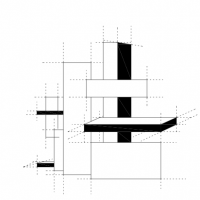
DEPUÉS DE EINSTEIN: UNA ARQUITECTURA PARA UNA TEORÍA
Estado:
Director/es:
En 1905, aparecen en la revista “Annalen der physik” tres artículos que revolucionarán las ciencias físicas y pondrán en jaque los asentados conceptos newtonianos de Espacio y Tiempo. La formulación de la Teoría de la Relatividad por Albert Einstein pone en crisis el valor absoluto de estos conceptos, y permite proponer nuevas reflexiones a propósito de su concepción dentro del campo de la física. Esta revolución ¿podría extrapolarse al campo de la arquitectura, donde Espacio y Tiempo tienen un papel protagonista?
Hay que entender la complejidad del hecho arquitectónico y las innumerables variables que participan de su definición. Se estudia en esta Tesis Doctoral un aspecto muy concreto: cómo un paradigma (la teoría de la relatividad) puede intervenir y modificar, o no, la arquitectura. Se plantea para ello ir al origen; desentrañar el momento de interacción entre la teoría de la relatividad y la teoría de la arquitectura, que permita determinar si aquella influyó sobre ésta en los escritos teóricos de las vanguardias aplicados a la arquitectura.
“Después de Einstein. Una arquitectura para una teoría” buscará los puntos de conexión de la teoría de la relatividad con la teoría arquitectónica de las vanguardias de principio del siglo XX, su influencia, la contaminación entre una y otra, con posibles resultados arquitectónicos a partir de esta interacción, capaz de definir nuevos argumentos formales para un nuevo lenguaje en arquitectura.
Para ello la Tesis se estructura en cuatro capítulos. El primero expone el ámbito geográfico y cronológico donde se desarrolla la teoría de la relatividad con la repercusión teórica que tiene para el arte, en función de una nueva definición de espacio vinculado al tiempo, como evento que se desarrolla en un ámbito cuatridimensional; la indeterminación de las medidas de espacio y de las medidas de tiempo, y la importancia de entender la materia como energía.
El segundo capítulo estudia los movimientos de vanguardia coetáneos a la eclosión de la relatividad, enmarcados en su ámbito geográfico más próximo. El cubismo se muestra como movimiento que participa ocasionalmente de las matemáticas y la geometría, bajo el influjo del científico Henri Poincaré y las geometrías no euclidianas. El futurismo indaga en los avances de la ciencia desde una cierta lejanía, cierta falta de rigor o profundidad científica para extraer las leyes de su nuevo idealismo plástico constructivo, definiendo e interpretando su Universo a partir de los avances de la ciencia, en respuesta a la crisis del espacio y del tiempo newtonianos. El lenguaje científico se encuentra presente en conceptos como “simultaneidad” (Boccioni), “expansión esférica de la luz en el espacio” (Severini y Carrá), “cuatridimensionalidad”, “espacio-tiempo”, “aire-luz-fuerza”, “materia y energía” que paralelamente conforman el cuerpo operacional de la teoría de Einstein. Si bien no es posible atribuir a la teoría de la relatividad un papel protagonista como referente para el pensamiento artístico, en 1936, con la aparición del manifiesto Dimensionista, se atribuyen explícitamente a las teorías de Einstein las nuevas ideas de espacio-tiempo del espíritu europeo seguido por cubistas y futuristas.
El tercer capítulo describe cómo la teoría de la relatividad llegó a ser fuente de inspiración para la teoría de la arquitectura. Estructurado en tres subcapítulos, se estudia el autor principal que aportó para la arquitectura conceptos e ideas extrapoladas de la teoría de la relatividad después de su estudio e interpretación (Van Doesburg), dónde se produjeron las influencias y puntos de contacto (Lissitzky, Eggeling, Moholy-Nagy) y cómo fueron difundidas a través de la arquitectura (Einsteinturm de Mendelsohn) y de las revistas especializadas.
El cuarto capítulo extrae las conclusiones del estudio realizado en esta Tesis, que bien pudiera resumir Moholy Nagy en su texto “Vision in motion” (1946) al comentar:
“Ya que el “espacio-tiempo” puede ser un término engañoso, tiene que hacerse especialmente hincapié en que los problemas de espacio-tiempo en el arte no están necesariamente basados en la teoría de la relatividad de Einstein. Esto no tiene intención de descartar la relevancia de su teoría para las artes. Pero los artistas y los laicos rara vez tienen el conocimiento matemático para visualizar en fórmulas científicas las analogías con su propio trabajo. La terminología de Einstein del “espacio-tiempo” y la “relatividad” ha sido absorbida por nuestro lenguaje diario.”

